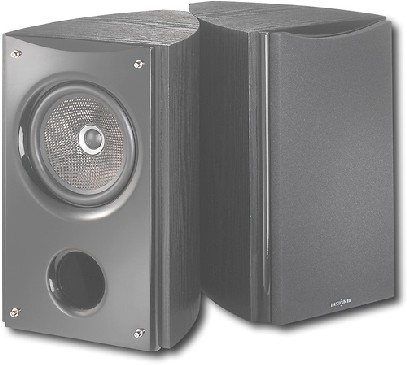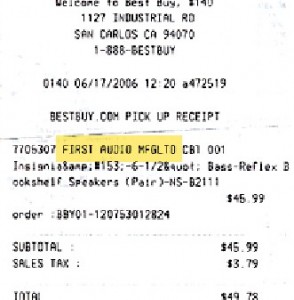If you’ve been reading any of the popular audio online bulletin boards over the past few weeks, chances are you’ve heard about the new Insignia 6-1/2″ bookshelf speakers available from Best Buy for $50 a pair. If you haven’t, let me enlighten you: the internet hype machine has been going wild over these things. Threads on every major audio-related board1 overflow with discussion, photos, measurements, and glorious praise:
“This purchase is the sweetest sweet spot I’ve encountered to date in my two and a half
years in this hobby.”“I think this speaker compares with those in the $100-$300 range.”
“For 50 bucks, nothing I have ever heard will touch it, or even come close.”
…and on and on. Well, I never want to miss out on the next big thing…trouble is I usually can’t afford it. But for $50 (with a 30-day unconditional moneyback guarantee), I could finally have a shot at running with the “in crowd”!
Thinking Out of the Box
Initial inspection revealed the build quality to be a bit spotty. The high points are quite high, insane actually for a $50 speaker: the beveled front baffle sports a gorgeous piano-gloss finish, and the binding posts are high quality WBT style (how insane is that? Real WBT binding posts sell for $70 a pair.). On the down side is the cabinet itself. It has an attractive, tapered shape, but fails the “knuckle wrap” test miserably…some serious cabinet resonance/poor damping going on there.
I quickly overlooked the gaff in the cabinet build once I got a good look at the main driver, however…its coaxial design is what caught the attention of the audiophile community in the first place. Coaxial means that the woofer and the tweeter are in the same unit, with the tweeter in the center of the larger woofer. This can result in excellent phase characteristics, and is a feature normally seen only in speakers that cost significantly more than the Insignias. Also of note are the driver materials: a silk dome tweeter and, get this! A bass driver made of woven carbon fiber! Speaker builders argue all day long about the virtues and vices of different driver materials2…paper, plastic, metal, hemp, banana pulp, etc.…which must adhere to a contradictory set of qualities: stiff yet lightweight, durable yet pliable, etc. Carbon fiber is highly regarded, and (normally) very expensive.
So, Why Are These Things So Cheap?
I puzzled over this for a time. Turns out most of the answer was sitting right in my hot little fist as I strolled out of my local Best Buy:
First Audio Manufacturing Ltd. is a 25-year old Hong Kong audio firm that runs an 860,000 square-foot factory in China’s booming Guangdong province. Each day, 750 workers crank out 300 pairs of speakers, as well a variety of other consumer electronics, for sale in Europe, Asia, Australia, and more recently in the U.S. First Audio is predominantly an OEM for other companies, but they do market products under their own brand names: Fidek and DJ-Tech.
So when you combine inexpensive manufacturing (the average annual salary in the Guandong province is well under $10,000 a year) with Best Buy’s buying power (Insignia is their house brand, and they have over 740 stores in the U.S. alone) you get some serious economy of scale going on. Plus, Best Buy doesn’t necessarily need to make a profit on each pair of speakers sold, they count on making money from the cables, stands, DVD players, or that new washer/dryer you might pick up while waiting in line to pay for your $50 wunderkinds.
Insignia 6-1/2″ Bass-Reflex speakers review
Yeah, Yeah, Okay…but How Do They Sound?
Well, there is typically an element of truth to any internet-driven hype, but a fair bit of hyperbole as well. Truth is, they sound darn good for $50. Now, I must qualify that with the kind of sound I would expect from $50 speakers: easily distorted, a smiley-faced frequency response with bass than booms (or is missing entirely), a recessed midrange, and treble peaks so shrill they threaten to tear the skin off your eardrums. The Insignias are certainly better than all that.
Far and away, their greatest strength is imaging…this is where the coaxial driver really shines. Their soundstage is wide (although not the widest I’ve heard), deep and threedimensional. These speakers pull off a good disappearing act: instrument placement is palpable and precise. I heard a pair of Quad ESLs a few weeks ago that clock in at, oh, 16,000% of the price of the Insignias, and they couldn’t image their way out of a paper bag. It might have been a placement problem, and certainly the Insignias have none of the Quad’s exquisite midrange and high end sweetness, but if I’m going to buy a pair of speakers that does some things well and other things not-so-well, I’d much rather spend $50 than $8000.
But I digress.
The bass on the Insignias is really quite good. There’s not a ton of it (they’re bookshelves, after all) but it is smooth, and rolls off in such a way that you don’t really miss the lower octaves. The midrange and treble are where the trouble is: frequency response is pretty ragged. The peaks and valleys aren’t exactly at Himalayan levels, but more Appalachian: the speakers aren’t grating or even terribly fatiguing, instruments just don’t sound natural. The midrange is honky, upper-mids are veiled, hard esses are emphasized in the treble, while some upper harmonics are muffled, giving cymbals a coloration reminiscent of pie tins. It has been suggested in some of the online discussion about the Insignias that it is pedantic to analyze these according to the usual audiophile prattle, and doing so misses the point of this inexpensive, over-achieving speaker. Well, amen to that! However, with all the hype these are generating, I’d just like it on the table that if you already have a set of speakers you enjoy, the Insignias are unlikely to dethrone them, and you needn’t go out and get a pair “just because they’re so cheap.” If you’re already reasonably happy with your system, you’d probably get more musical enjoyment out of a few new CDs.
Buying Advice
If you need speakers and all you have is $50, your short list begins and ends right here. Outside of a lucky garage sale find, these will not be easily beat. There’s a few other situations where I think the Insignias would be a worthwhile purchase:
-
2nd (or 3rd or 4th) Sound Systems
Need tunes in your bedroom, den, houseboat, garage, or laundry room? Here you go.
- Computer Sound
Combined with a Sonic Impact T-amp ($35), the Insignias would smoke just about any computer speakers on the market, including those with subwoofers. The only caveat is you’d need a lot of desk or shelf space… while technically they are small speakers, they are enormous compared to most computer sound systems. Also, they’re not shielded, so you won’t want them too close to your monitor.
- As a Project
Much has been written already about ways to improve the Insignias, mostly to do with cabinet stiffening and modifications to the crossover. Danny Richie3 even has a kit available at his website. If you’ve ever been curious about designing or building speakers, this is the least expensive way I know of to learn a thing or two and wind up with a decent sounding end-result. Not to be overlooked is Best Buy’s 30-day money back guarantee. I’d feel a twinge of guilt trying this at a small, independently run shop, but for a conglomerate like Best Buy, who cares? Pick up a pair just to get that new gear smell going in your system again, beat them up with some heavy-bass material for a few days, then sit down for a fresh perspective on your CD collection. If the Insignias don’t float your boat for any reason at all, bring ‘em on back to the store, no questions asked. As soon as this review gets sent off to Mark, that’s exactly where mine are going.

